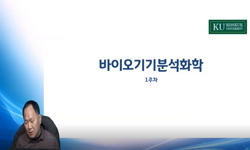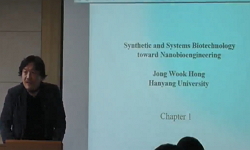본 연구에서는 PCR-DGGE 기법을 이용하여 DO 농도에 따른 동시 질산화·탈질 반응조 내 미생물 군집 변화 양상을 규명하고자 하였다. DO 농도의 변화에 따른 eubacteria의 군집 변화 해석 실험에서, ...
http://chineseinput.net/에서 pinyin(병음)방식으로 중국어를 변환할 수 있습니다.
변환된 중국어를 복사하여 사용하시면 됩니다.
- 中文 을 입력하시려면 zhongwen을 입력하시고 space를누르시면됩니다.
- 北京 을 입력하시려면 beijing을 입력하시고 space를 누르시면 됩니다.

생물학적 질소제거 공정에서 용존산소변화에 따른 미생물의 군집변화 = Changes of Microbial Community Depending on Different Dissolved Oxygen in Biological Nitrogen Removal Process
한글로보기https://www.riss.kr/link?id=A102152120
- 저자
- 발행기관
- 학술지명
- 권호사항
-
발행연도
2008
-
작성언어
Korean
- 주제어
-
등재정보
KCI등재
-
자료형태
학술저널
- 발행기관 URL
-
수록면
939-947(9쪽)
-
KCI 피인용횟수
2
- 제공처
- 소장기관
-
0
상세조회 -
0
다운로드
부가정보
국문 초록 (Abstract)
본 연구에서는 PCR-DGGE 기법을 이용하여 DO 농도에 따른 동시 질산화·탈질 반응조 내 미생물 군집 변화 양상을 규명하고자 하였다. DO 농도의 변화에 따른 eubacteria의 군집 변화 해석 실험에서, DO 농도를 2와 1 mg/L로 운전한 반응조 내의 band profile은 거의 유사하게 관찰되었으며 5종의 우점화 미생물(Uncultured Bacterium 3종, Bacillus sp. 1종, Uncultured Bacteroidetes sp. 1종)을 포함한 16종의 미생물을 동정할 수 있었다. 그리고 DO 농도 0.5 mg/L로 운전한 반응조 내의 DGGE 결과 7종의 우점화 미생물(Uncultured Bacterium 5종, Zoogloea sp. 2종)을 포함한 12종의 미생물을 동정할 수 있었으며, DO 농도 0.1 mg/L로 운전한 반응조의 경우 3종의 우점화 미생물(Uncultured Bacterium 1종, Zoogloea sp. 2종)을 포함한 11종의 미생물을 동정할 수 있었다. 반응조 내 DO 농도의 변화에 따른 β-AOB(β-Ammonia Oxidizing Bacteria)의 군집 변화 해석 실험 결과, 하나의 band를 관찰할 수 있었다. 이 band는 Uncultured Nitrosomonas sp. done DNB Y20와 97%의 유사도를 갖는 것으로 나타났으며 2, 1, 그리고 0.5 mg/L의 DO 농도에서 추출한 sample에서는 선명하게 관측되었으나, 0.1 mg/L DO 농도에서 추출한 sample에서는 선명도가 현저히 감소하였다. 이는 NH₄+-N의 질산화 양상과 상관관계가 있음을 보였다. 반응조 내 DO 농도에 따른 탈질 bacteria의 군집 변화 해석실험 결과, 다섯 개의 band(nirS를 함유하는 Uncultured organism 미생물 3종, nirK를 함유하는 Uncultured bacterium 미생물 2종)가 관측되었으며 관측된 band 중 한 band는 DO 농도가 낮아질수록 선명도가 현저히 증가하는 것을 확인할 수 있었다. 이 band에 해당하는 미생물은 86%의 유사도를 가진 Uncultured organism clone eS1 cd1 nirS gene, partial cds로, 본 연구의 탈질 반응에 직접 적으로 관여 하는 미생물로 사료된다.
다국어 초록 (Multilingual Abstract)
PCR-DGGE method was applied to analyze changes of microbial community in simultaneous nitrification and denitrification (SND) bioreactor with various DO concentrations. In the analysis of eubacterial community, band profiles of DGGE were similar with ...
PCR-DGGE method was applied to analyze changes of microbial community in simultaneous nitrification and denitrification (SND) bioreactor with various DO concentrations. In the analysis of eubacterial community, band profiles of DGGE were similar with 2 or 1 mg/L DO concentrations in the reactor. Experimental results led to 16 different bacteria being identified, including 5 dominant strains(3 strains of Uncultured Bacterium, 1 strains of Bacillus, 1 strains of Uncultured Bacteroidetes). DGGE results at 0.5 mg/L DO concentration led to 12 strains being identified, including 7 dominant strains(5 strains of Uncultured Bacterium, 2 strains of Zoogloea sp.). DGGE results at 0.1 mg/L DO concentration led to 11 strains being identified, including 3 dominant strains(1 strains of Uncultured Bacterium, 2 strains of Zoogloea sp.). In DGGE band profiles of β-AOB(β-Ammonia Oxidizing Bacteria), only one band was observed. This band had 97% similarity with Nitrosomonas sp. done DNB Y20. This band was clearly observed at the 2, 1 and 0.5 mg/L DO concentrations, while the brightness of the band at 0.1 mg/L DO concentration was mostly dimmed. In DGGE band profiles of denitrification process, 5 bands(3 strains of Uncultured organism containing nirS, 2 strains of Uncultured organism containing nirK) were observed. Among those bands, the brightness of one band was gradually increased at the lower DO concentrations. This band has 86% identity with Uncultured organism clone eS1 cd1 nirS gene, partial cds. Based on this result, it could be concluded that Uncultured organism clone eS1 cd1 nirS gene, partial cds is a predominant microorganism in the denitrification process.
참고문헌 (Reference)
1 Metcalf & Eddy, "폐수처리공학2" 1048-1248, 2004
2 Garbriel Bitton, "폐수 미생물" 247-312, 2004
3 권문선, "탈질균의 호기성상태에서 탈질 특성에 관한 기초적 연구" 143-148, 1992
4 Pochana, K., "Study of factors affecting simultaneous nitrification and denitrification(SND)" 39 (39): 61-68, 1999
5 APWA, "Standard methods for the examination of water and wastewater" 1999
6 Halling, S. B., "Simultaneous nitrification and denitrification with an upflow fixed bed reactor applying clinoptililite as media" 7 : 77-88, 1992
7 Watanebe, Y., "Simultaneous nitrification and denitrification in micro-aerobic biofilms" 26 (26): 511-522, 1992
8 Munch, E. V., "Simultaneous nitrification and denitrification in bench-scale sequencing batch reactors" 30 (30): 277-285, 1996
9 Watanebe, T., "Simultaneous nitrification and denitrification in a single reactor using a bioelectro- chemical process" 46 (46): 163-169, 2002
10 Gupta, S. K., "Simultaneous nitrification and denitrification in a rotating biological contactor" 15 : 145-153, 1994
1 Metcalf & Eddy, "폐수처리공학2" 1048-1248, 2004
2 Garbriel Bitton, "폐수 미생물" 247-312, 2004
3 권문선, "탈질균의 호기성상태에서 탈질 특성에 관한 기초적 연구" 143-148, 1992
4 Pochana, K., "Study of factors affecting simultaneous nitrification and denitrification(SND)" 39 (39): 61-68, 1999
5 APWA, "Standard methods for the examination of water and wastewater" 1999
6 Halling, S. B., "Simultaneous nitrification and denitrification with an upflow fixed bed reactor applying clinoptililite as media" 7 : 77-88, 1992
7 Watanebe, Y., "Simultaneous nitrification and denitrification in micro-aerobic biofilms" 26 (26): 511-522, 1992
8 Munch, E. V., "Simultaneous nitrification and denitrification in bench-scale sequencing batch reactors" 30 (30): 277-285, 1996
9 Watanebe, T., "Simultaneous nitrification and denitrification in a single reactor using a bioelectro- chemical process" 46 (46): 163-169, 2002
10 Gupta, S. K., "Simultaneous nitrification and denitrification in a rotating biological contactor" 15 : 145-153, 1994
11 Sen, P., "Simultaneous nitrification and denitrification in a fluidized bed reactors" 38 (38): 247-254, 1998
12 Hibiya, K., "Simultaneous nitrification and denitrification by controlling vertical and horizontal microenvironment in a membrane -aerated biofilm reactor" 100 : 23-32, 2003
13 Moriyama, K., "Simultaneous biological removal of nitrogen and phosphorus using oxic-anaerobic-oxic process" 22 (22): 61-66, 1990
14 Menoud, P., "Simultaneous Nitrification and Denitrification Using SIPORAXTMPACKING" 40 (40): 153-160, 1999
15 Trivedi, H., "Simultaneous Nitirification/ Denitrification by Mornitoring NAOH Fluorescene in Activated Sludge" 2000
16 Rittman, B. E., "Simultaneous Denitrification with Nitrification in Single-Channel Oxidation Ditches" 57 : 300-, 1985
17 이진옥, "Real-time PCR을 이용한 BioCube 내부 탈질 미생물 분포 측정" 164-168, 2005
18 Muyzer, G., "Profiling of Complex Microbial Populations by Denaturing Gradient Gel Electrophoresis Analysis of Polymerase Chain Reaction-Amplified Genes Coding for 16S rRNA" 59 : 695-700, 1993
19 정수희, "PCR-DGGE를 이용한 호기성 고정생물막내 질산화 미생물의 군집해석" 부산대학교 대학원 환경공학과 2005
20 Kugleman, I. J., "Nutrient removal in staged biological reactors" 4-27, 1988
21 Christensen, M. H., "Nitrification and denitrification in wastewater treatment. In: Water Pollution Microbiology. 2" John Wiley & Sons 391-414, 1978
22 Pochana, K., "Model development for simultaneous nitrification and denitrification" 39 (39): 235-243, 1999
23 Gesche Braker, "Development of PCR primer system for amplication of nitrite reductase genes(nirK and nirS) to detect denitrifying bacteria in environment samples" 3769-3775, 1998
24 Mannix Salvador Pedro, "Denaturing Gradient Gel Electrophoresis Analysis of microbial community from field-scale composter" 91 (91): 159-165, 2001
25 Holman, J. B., "COD, ammonia and dissolved oxygen time profiles in the simultaneous nitrification/denitrification process" 22 : 125-133, 2005
26 Masuda, S., "Biofilm properties and simultaneous nitrification and denitrification in aerobic rotating biological contactors" 23 : 1355-1363, 1991
27 Fuerhacker, M., "Approach for a novel control strategy for simultaneous nitrification-denitrification in activated sludge reactors" 2499-2506, 2000
28 Muyzer, G., "Application of denaturing gradient gel electrophoresis(DGGE) and temperature gradient gel electrophoresis(TGGE) in microbial ecology" 73 : 128-141, 1998
29 Claudia Schabereiter-Gurtner, "Application of broad- range 16S rRNA PCR amplication and DGGE fingerprinting for detection of tick- infecting bacteria" 52 : 251-260, 2003
30 Irvine, R. L., "Analysis of full-scale SBR operation at Grundy Centre, IOWA" 59 (59): 132-138, 1987
31 Emilie Lyautey, "Analysis of bacterial diversity in river biofilms using 16S rRNA PCR-DGGE: methodological setting and fingerprints interpretation" 39 : 380-388, 2005
동일학술지(권/호) 다른 논문
-
- 大韓環境工學會
- 최정현(Jung Hyun Choi)
- 2008
- KCI등재
-
활성탄 재질 및 사용연수에 따른 Tetracycline계 항생물질 흡착특성
- 大韓環境工學會
- 손희종(Hee Jong Son)
- 2008
- KCI등재
-
- 大韓環境工學會
- 이준철(Jun Cheol Lee)
- 2008
- KCI등재
-
침지형 생물 반응기 공정에서 플럭스 향상을 위한 공기 세척 효과에 관한 연구
- 大韓環境工學會
- 신동환(Dong Hwan Shin)
- 2008
- KCI등재
분석정보
인용정보 인용지수 설명보기
학술지 이력
| 연월일 | 이력구분 | 이력상세 | 등재구분 |
|---|---|---|---|
| 2027 | 평가예정 | 재인증평가 신청대상 (재인증) | |
| 2021-01-01 | 평가 | 등재학술지 유지 (재인증) |  |
| 2018-01-01 | 평가 | 등재학술지 선정 (계속평가) |  |
| 2017-12-01 | 평가 | 등재후보로 하락 (계속평가) |  |
| 2013-01-01 | 평가 | 등재 1차 FAIL (등재유지) |  |
| 2010-01-01 | 평가 | 등재학술지 유지 (등재유지) |  |
| 2008-01-01 | 평가 | 등재학술지 유지 (등재유지) |  |
| 2006-01-01 | 평가 | 등재학술지 유지 (등재유지) |  |
| 2004-01-01 | 평가 | 등재학술지 유지 (등재유지) |  |
| 2001-01-01 | 평가 | 등재학술지 선정 (등재후보2차) |  |
| 1998-07-01 | 평가 | 등재후보학술지 선정 (신규평가) |  |
학술지 인용정보
| 기준연도 | WOS-KCI 통합IF(2년) | KCIF(2년) | KCIF(3년) |
|---|---|---|---|
| 2016 | 0.52 | 0.52 | 0.45 |
| KCIF(4년) | KCIF(5년) | 중심성지수(3년) | 즉시성지수 |
| 0.43 | 0.42 | 0.604 | 0.13 |




 ScienceON
ScienceON DBpia
DBpia






